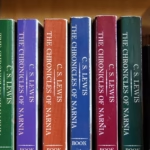Read every series in the right order

The Lunar Chronicles Books in Chronological Order – Complete Reading Guide
Table of Contents
Quick Answer (TL;DR)
Read the four main novels in publication order (which also matches in-universe sequence):
Cinder (2012) → Scarlet (2013) → Cress (2014) → Winter (2015).
If you want the expanded experience, add the companions in this recommended spotlights order from the author’s guidance: Cinder → Scarlet → Cress → Fairest (Levana prequel) → Winter → Wires & Nerve (Vols. 1–2) → Stars Above (short-story collection with the epilogue).
Introduction
Futuristic fairytales. Political intrigue. Found family. High-stakes heists and heart. When readers ask us for The Lunar Chronicles Books in Chronological Order, they usually want two things at once: (1) the fastest “correct” way to read through the core quartet—Cinder, Scarlet, Cress, Winter—and (2) a smart plan for weaving in the beloved companion volumes (Fairest, Stars Above, and the graphic-novel duology Wires & Nerve). That’s exactly what this guide delivers—spoiler-light blurbs, clean buy links, a series timeline, and pro tips for formats and collectors.
We also keep this page current with adaptation news. As of June 9, 2025, Warner Bros. Pictures Animation and Locksmith Animation set an animated feature of The Lunar Chronicles for a November 2028 theatrical release, directed by Noëlle Raffaele; Kalen Egan & Travis Sentell attached as writers, with Industrial Light & Magic involved. (Details below.)
Quick Facts
| Item | Details |
|---|---|
| Series | The Lunar Chronicles by Marissa Meyer (four core novels + companion works) |
| Primary Genres | YA science fiction, fairytale retellings, space opera, political intrigue |
| Typical Length (core) | Cinder ~400 pp, Scarlet ~464 pp, Cress ~560 pp, Winter ~832 pp (Feiwel & Friends/Macmillan listings). |
| Estimated Read Time | ~8 hours per 400 pages at 250 wpm; the full quartet ~45–50 hours (print). |
| Reading Difficulty | Accessible YA; some invented tech/geo-political terms; strong character focus. |
| Content Notes | Disease/pandemic themes, body autonomy/augmentation, war/insurrection, off-page torture/violence, mind control, romance (clean–PG-13). |
| Ideal Age Range | 12–18 (publisher age band); widely enjoyed by adults. |
| Media Adaptations | Animated feature film in development; theatrical release planned Nov 2028 (WB/Locksmith; director Noëlle Raffaele; writers Kalen Egan & Travis Sentell; ILM involved). |
About The Lunar Chronicles Book Series
Set in a near-future world where Earth and Luna (the Moon) are political rivals, The Lunar Chronicles re-imagines classic fairytales with cybernetics, bio-engineering, and interplanetary power plays. Each novel introduces a heroine inspired by a fairytale archetype—Cinder (Cinderella), Scarlet (Little Red Riding Hood), Cress (Rapunzel), Winter (Snow White)—then braids their stories into a single rebellion against Queen Levana of Luna.
Meyer’s hook is simple but brilliant: give each heroine her own book-length arc, then assemble the cast into a heist-flavored ensemble saving the world. The result is a page-turning blend of found family and space-opera stakes, anchored by sharp banter and big hearts.
The Lunar Chronicles Books at a Glance
| # | Title | Amazon Buy Link |
|---|---|---|
| 1 | Cinder | Buy on Amazon |
| 2 | Scarlet | Buy on Amazon |
| 3 | Cress | Buy on Amazon |
| 4 | Winter | Buy on Amazon |
| — | Fairest (Levana prequel) | Buy on Amazon |
| — | Stars Above (short stories + epilogue) | Buy on Amazon |
| — | Wires & Nerve Vol. 1 (graphic novel) | Buy on Amazon |
| — | Wires & Nerve Vol. 2: Gone Rogue | Buy on Amazon |
The Lunar Chronicles chronological Reading Order
This “chronological” list preserves the story flow of the main quartet and slots the companions where they enhance character motivation and world-building (without spoiling surprises). When in doubt, follow the author’s release-order recommendation; we mirror it and note where a prequel fits emotionally.
1) Cinder (2012)
Where we begin: New Beijing, crowded markets, creaking androids, and a deadly plague. Cinder, a gifted teenage mechanic and cyborg, is our Cinderella—not glass slippers, but grease-stained gloves and a secret past. A chance encounter with Prince Kai drags her into imperial politics and Lunar schemes.
Why it goes first: This is the foundation—tech, geopolitics, plague stakes, the Lunar threat, and Cinder’s identity puzzle. Page count and YA banding from the publisher give you a sense of scope: ~400 pages; ages 12–18.
2) Scarlet (2013)
Enter: Scarlet Benoit (our Red Riding Hood), her missing grandmother, and a street fighter named Wolf who may be ally, enemy, or both. Meanwhile Cinder’s status changes from unknown to fugitive, and the world starts connecting dots that Lunars would rather keep buried.
Why second works: It expands the map—France, the Rampion ship, the threads tying Scarlet’s family to Cinder’s past—and introduces the Wolves (bio-engineered soldiers). Expect a bigger canvas (~464 pages; ages 12–18).
3) Cress (2014)
Enter: Cress (our Rapunzel), a genius hacker imprisoned on a satellite since childhood. She’s been tasked with tracking Cinder’s crew—but might just flip sides. A rescue attempt goes sideways, scattering the team across Earth and space, while Queen Levana moves to cement power.
Why third sings: It’s the “everyone levels up” book—romance deepens, villainy sharpens, the heist gets hairy, and Cress’s POV reframes the stakes as global. It’s also the lengthiest mid-series entry (~560 pages), a true space-opera sprawl.
★ Optional bridge before the finale: Fairest (2015, Levana’s backstory)
What it is: A Levana character study—how the tyrant of Luna became who she is. Chronologically it takes place years before the quartet, but Meyers herself suggests reading in publication order (i.e., here, after Cress and before Winter) so you’ll get the maximum emotional punch in the finale.
Why place it here: You go into Winter with Levana’s psyche fresh, deepening every palace scene and moral choice. (If you’d prefer no softening of the villain, you can save Fairest for after Winter; the author notes the trade-off herself.)
4) Winter (2015)
Enter: Princess Winter (our Snow White) and palace guard Jacin Clay. The ensemble converges on Luna for a high-risk revolution. The scope is epic—crowds, corridors, coups—and the page count reflects it (~832 pages).
Why it closes the main arc: This is the pay-off for every breadcrumb since page one: identity, autonomy, truth versus manipulation, and love in the crossfire. All four heroines carry a column of the plot; when they lock, the edifice holds.
Post-quartet, in-world continuations
- Wires & Nerve, Vols. 1–2 — Graphic novel duology starring Iko (set after Winter, and—per the author—before the Stars Above epilogue). Expect mission-style adventures, a new villain, and closure on the Wolf-soldier threat.
- Stars Above — Nine stories set around the series timeline (six prequels + alternate POVs) plus the official epilogue “Something Old, Something New,” which reunites the whole crew for the wedding of the century. Read it last for maximum warm-fuzzy impact.
Series Timeline & Character Development
Cinder — A mechanic who starts the story “less than” in her society’s eyes. Her arc is about agency: owning her body, her power, and her right to lead—even when the world, and empires, forbid it.
Scarlet — Loyalty in a red hoodie. Her through-line is fierce devotion (to truth, to family) and how love can be both dangerous and liberating when the other person has been engineered for violence.
Cress — A dreamer who weaponizes hope. Growth = from fangirl to force: she moves from adoring heroes to becoming one, blending fear with cunning.
Winter — Kindness as rebellion. Her refusal to use Lunar mind-control (“glamour”) costs her dearly, but it becomes the moral center that cracks Levana’s regime.
Kai, Thorne, Wolf, Jacin — Each male lead complements rather than eclipses the heroines: Kai’s diplomacy versus duty; Thorne’s rogue-with-a-heart; Wolf’s feral tenderness; Jacin’s quiet stubbornness.
Iko — The soul of the series. In the graphic novels she steps from best-friend confidante into hero with her own stakes, proving that personhood isn’t a matter of flesh.
Novels sorted in order of in-universe events
(“Novels” = the four-book mainline. Companion placements follow in the next sections.)
- Cinder
- Scarlet
- Cress
- Winter
Note: Fairest (Levana’s backstory) is set earlier chronologically, but most readers (and the author) prefer it between Cress and Winter for emotional resonance.
Novels sorted in order of publication
- Cinder (2012)
- Scarlet (2013)
- Cress (2014)
- Winter (2015)
Publisher pages confirm page counts and age banding for each.
Companion Works
1. Fairest (2015) — Levana’s Story
A full-length villain-origin about Queen Levana. Chronologically a prequel; recommended between Cress and Winter for best payoff (or after Winter if you want to avoid any sympathy for Levana before the finale).
2. Stars Above (2016) — Short-Story Collection + Epilogue
Nine tales spanning the timeline (e.g., The Mechanic, The Queen’s Army, After Sunshine Passes By) and the series’ official epilogue, “Something Old, Something New.” Read last—it’s the celebration after the storm.
3. Wires & Nerve, Vols. 1–2 (2017–2018) — Graphic Novels
Set after Winter and before the Stars Above epilogue, starring Iko and featuring a new antagonist tied to the Wolf-soldier program. If you like team-mission arcs and visual storytelling, these two are a joy.
Editions & Formats (hardcover, collector, audio)
Hardcover / Trade Paperback
- Feiwel & Friends (Macmillan) is the home imprint. Approximate page counts: Cinder ~400, Scarlet ~464, Cress ~560, Winter ~832. Match a single trim for a neat shelf.
Audiobooks
- Unabridged editions available across the core and companions; the ensemble cast and fast pacing translate cleanly to audio.
Graphic Novels
- Wires & Nerve duology boxed sets are widely available; perfect if you want a contained post-finale arc in one package.
Collector Tips
- First-print hardcovers with intact jackets remain the classic set.
- For a cohesive look, pair the hardcover quartet + HC Fairest; shelve Stars Above last (spine art complements).
- Graphic novels: consider the boxed set to keep art continuity.
Why Read The Lunar Chronicles Books in Chronological Order?
- Momentum & Mystery: Each book reveals information the next assumes—reading out of order robs reveals of their punch.
- Villain Depth, Not Deflation: Placing Fairest before Winter enriches the finale’s palace politics without excusing Levana; the author herself suggests it enhances Winter.
- True “Last Page” Feeling: Saving Stars Above (epilogue) for the end gives you the earned “happily ever after.”
- Clean Post-Finale Adventure: Slotting Wires & Nerve after Winter (and before the epilogue) gives Iko’s story space to shine, then lets the epilogue tie a bow.
Author Spotlight: Marissa Meyer
Marissa Meyer is the self-proclaimed fangirl who turned fairy tales into rocket fuel. Beyond The Lunar Chronicles, she’s written Heartless (an Alice-adjacent origin for the Queen of Hearts) and the Renegades trilogy (superhero politics and power). On her site and blog, Meyer has long been transparent about reading order and companion placements—most notably recommending publication order as the default, with optional tweaks for Fairest and Wires & Nerve.
What makes Meyer’s storytelling stand out is the balance of genre mash-up (SF + fairy tales) with character-first plotting. She understands that a revolution only matters if we care who’s risking everything to start it—and we do.
Media Adaptations (films, TV, radio)
- Feature Film (Animated): On June 9, 2025, multiple industry outlets reported that Warner Bros. Pictures Animation and Locksmith Animation will bring The Lunar Chronicles to theaters, with a November 2028 release window. Noëlle Raffaele is attached to direct, with a script by Kalen Egan & Travis Sentell; ILM is involved on the production side.
- Status: Development underway; as always, dates and teams can evolve across animation pipelines. (We’ll update this section as new confirmations roll out.)
FAQs
Do I need to read the companions?
No—but you’ll likely want to. Fairest deepens the villain before Winter; Wires & Nerve gives you a delightful Iko-led coda; Stars Above provides the official epilogue (“Something Old, Something New”)—save it for dessert.
Is “Stars Above” really the end?
Yes, emotionally. The epilogue reunites the crew for a wedding and a collective exhale—best experienced after all prior installments.
What age is this for?
Publisher age band is 12–18; adult readers are a huge part of the fandom. Expect PG-13 intensity and romance.
Are the page counts intimidating?
Only Winter is truly doorstopper-sized (~832 pp). The short-chapter, multi-POV pacing keeps things flying.
Where do the graphic novels fit, exactly?
After Winter and before the Stars Above epilogue, per Meyer’s own blog announcement when the project was greenlit.
Final Thoughts
If you’re mapping The Lunar Chronicles Books in Chronological Order, think of it like programming the Rampion’s flight path: you want the most efficient route with the best views.
- Start with Cinder, because everything—tech, politics, hearts—begins there.
- Stay in publication order through Scarlet and Cress.
- Slot Fairest before you board Winter (or after, if you prefer a pure-villain finale).
- Celebrate the victory with Wires & Nerve (Iko time!) and then Stars Above for the epilogue that lets you say goodbye the right way.
Whether you’re here for the romance, the revolution, or the robots, this order preserves the gasp-moments, amplifies the feels, and gets you the complete experience—no spoilers, no confusion, all joy.







